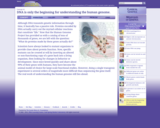
The full text of Richard Sheridan's "The Critic." Includes an introduction with information on Sheridan's life and works.
- Subject:
- Arts
- Material Type:
- Textbook
- Provider:
- Bibliomania
- Date Added:
- 10/03/2023

The full text of Richard Sheridan's "The Critic." Includes an introduction with information on Sheridan's life and works.

A very comprehensive site that includes a biographical sketch, several texts of Borges'poems, short stories and essays and, critical essays on his works.

This lesson plan examines methods of critiquing and review films based on elements of sight and sound. Included in the lesson plan is an overview, practice, objectives, resources, preparation, and more.

This resource provides a definition and demonstration of the cross product.

At this univeristy physics department site, the polarization of light is explained and illustrated. Methods for analyzing light to determine the degree of polarization are stated and explained with equations.

Ibiblio.org provides a brief background of the crisis and links to letters (originals and translations) exchanged between JFK and Khrushchev.

Provides examples of the Quechua language such as riddles, poetry, short stories and other written forms. Contains a link to photos from the Andes.

Complete descriptions of microtubules and microfilaments. Flip to the following pages to go through a cytoskeleton tutorial with graphics of cross-sections and diagrams. You can test yourself at the end.

These photographs supplied by Genelex Corporation depict actual DNA fingerprints and show the types of information that can be gleaned from them.

Genes are actually a specific sequence of DNA and they have a clear start and stop. Learn about the discovery and sequencing of genes at this site. This multimedia article includes animations, pictures, video, biographical information, and quiz questions that are accessed by clicking on buttons along the bottom of the page.

This multimedia article includes animations, pictures, video, biographical information, and quiz questions that are accessed by clicking on buttons along the bottom of the page. The topic is the human genome.

A good tutorial on replication. The menu bar at the top provides more history, background and animations.

Bacterial conjugation and experiments with viruses indicated that they must also contain DNA. This multimedia article includes animations, pictures, video, biographical information, and quiz questions that are accessed by clicking on buttons along the bottom of the page.

Alfred Sturtevant will describe his gene mapping research with fruit flies. This animated explanation will show how he bred fruit flies to determine the proximity of genes.

The human genome project was established to determine the sequence of DNA bases that are found in each human cell. Understanding what the resulting proteins do is an entirely different project. This page is about how we are trying to understand what the human genome means, and includes animations, pictures, video, biographical information, and quiz questions that are accessed by clicking on buttons along the bottom.

The genetic code is actually the three letter combination of bases that codes for an amino acid. This article describes the discovery of this code. Article includes animations, pictures, video, biographical information, and quiz questions that are accessed by clicking on buttons along the bottom of the page.

The scientists and experiments that discovered that DNA is coiled into chromosomes are the topic of this article. Article includes animations, pictures, video, biographical information, and quiz questions that are accessed by clicking on buttons along the bottom of the page.

A nice tutorial on DNA structure. The menu at the bottom allows you to view some different information.

This multimedia article includes animations, pictures, video, biographical information, and quiz questions that are accessed by clicking on buttons along the bottom of the page. The topic is the study of cell division, mitosis, and cell death.

Many scientists have worked on discovering what genes are "turned on" within cells at different stages of development. DNA arrays and gene chips are techniques that have been developed. This article will help you understand these difficult concepts. Article includes animations, pictures, video, biographical information, and quiz questions that are accessed by clicking on buttons along the bottom of the page.